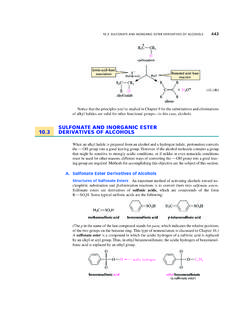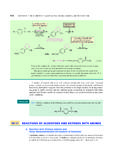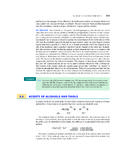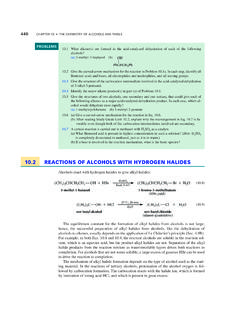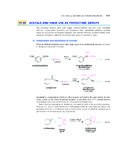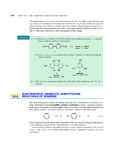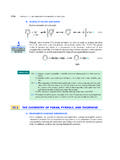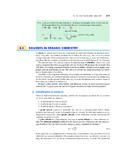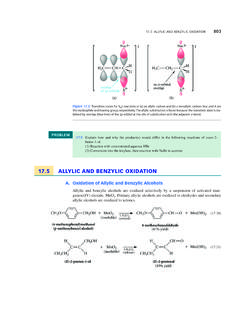Transcription of 21.7 HYDROLYSIS OF CARBOXYLIC ACID …
1 1004 CHAPTER 21 THE CHEMISTRY OF CARBOXYLIC acid substitution can be represented generally as follows, with E=an elec-trophilic group and Y= a nucleophilic group:The term acyl substitutioncomes from the fact that substitution occurs at the carbonyl carbonof an acyl group. In other words, an acyl group is transferred in Eq. between an LX anda LY group. The group LX might be the LCl of an acid chloride, the LOR of an ester, andso on; this group is substituted by another group LY. T h i s i s p r e c i s e l y t h e s a m e t y p e o f r e a c -tion as esterification of CARBOXYLIC acids (LX= LOH, ELY=HLOCH3; Sec. ).Acyl substitution reactions of CARBOXYLIC acid derivatives are the major focus of this nitriles are not carbonyl compounds, the C'N bond behaves chemically muchlike a carbonyl group.
2 For example, a typical reaction of nitriles is addition.(Compare this reaction with addition to the carbonyl group of an aldehyde or ketone.)Although the resulting addition products are stable in some cases, in most situations they aldehydes and ketones, CARBOXYLIC acid derivatives undergo certain reactionsinvolving the a-carbon. The a-carbon reactions of all carbonyl compounds are groupedtogether in Chapter 22. The reactivity of amides at nitrogen is discussed in Sec. OF CARBOXYLIC acid DERIVATIVESAll CARBOXYLIC acid derivatives have in common the fact that they undergo HYDROLYSIS (a cleav-age reaction with water) to yield CARBOXYLIC HYDROLYSIS of EstersSaponification of EstersOne of the most important reactions of esters is the cleavage re-action with hydroxide ion to yield a carboxylate salt and an alcohol.
3 The CARBOXYLIC acid itselfis formed when a strong acid is subsequently added to the reaction mixture.( )methyl 3-nitrobenzoate3-nitrobenzoic acid (90 96% yield)"%COCH3NO2_OHO%#Na|"%CO_NO2O%#"%CO HNO2O%#+CH3OH+20% NaOH 5 10 minHCl( )CRNEYL'CRNEYLL3+LA"2( )SLLCORLYE CARBOXYLIC acidderivativeanother CARBOXYLIC acidderivativeX+SLLCORLXEY+an acyl 12/15/08 11:44 AM Page HYDROLYSIS OF CARBOXYLIC acid DERIVATIVES1005 Ester HYDROLYSIS in aqueous hydroxide is called saponificationbecause it is used in theproduction of soaps from fats (Sec. ). Despite its association with fatty- acid esters, theterm saponificationcan be used to refer to the HYDROLYSIS in base of any CARBOXYLIC mechanism of ester saponification involves the reaction of the nucleophilic hydroxideion at the carbonyl carbon to give a tetrahedral addition intermediate from which an alkoxideion is alkoxide ion, after expulsion as a leaving group (methoxide in Eq.)
4 , reacts with theacid to give the carboxylate salt and the equilibrium in this reaction lies far to the right because the CARBOXYLIC acid is a muchstronger acid than methanol. Le Cha telier s principle operates: The reaction in Eq. the CARBOXYLIC acid from the equilibrium in Eq. as its salt and thus drives thehydrolysis to completion. Hence, saponification is effectively irreversible. Although an excessof hydroxide ion is often used as a matter of convenience, many esters can be saponified withjust one equivalent of _OH. Saponification can also be carried out in an alcohol solvent, eventhough an alcohol is one of the products of the reaction. If saponification were reversible, analcohol could not be used as the solvent because the equilibrium would be driven toward start-ing Ester HydrolysisBecause esterification of an acid with an alcohol is areversible reaction (Sec.)
5 , esters can be hydrolyzed to CARBOXYLIC acids in aqueous so-lutions of strong acids. In most cases, this reaction is slow and must be carried out with an ex-cess of water, in which most esters are insoluble. Saponification, followed by acidification, isa much more convenient method for HYDROLYSIS of most esters because it is faster, it is irre-versible, and it can be carried out not only in water but also in a variety of solvents expected from the principle of microscopic reversibility (Sec. ), the mechanism ofacid-catalyzed HYDROLYSIS is the exact reverse of the mechanism of acid -catalyzed esterifica-tion (Sec. ). The ester is first protonated by the acid catalyst:( )HLOH21CH3 RCLLO11SO33CH3 RHCLLO111SO3||%CH3 RHCLLO11O3||%"1CH3H2 RHCLO1O3%"+O11A( )pKa = = 15 RCLLO11SO33+_OCH33311_RCHLLLO11SO33+HLOC H311( )Rtetrahedraladdition intermediateCCH3 LLO11 RCCH3 LLO11SO33 HOH311_RC HLLO11SO33_""O331O31+ 12/15/08 11:44 AM Page 10051006 CHAPTER 21 THE CHEMISTRY OF CARBOXYLIC acid DERIVATIVESAs in other acid -catalyzed reactions at the carbonyl group, protonation makes the carbonylcarbon more electrophilic by making the carbonyl oxygen a better acceptor of electrons.
6 Water,acting as a nucleophile, reacts at the carbonyl carbon and then loses a proton to give the tetra-hedral addition intermediate:Protonation of the leaving oxygen converts it into a better leaving group. Loss of this groupgives a protonated CARBOXYLIC acid , from which a proton is removed to give the CARBOXYLIC s summarize the important differences between acid -catalyzed ester HYDROLYSIS andester saponification. First, in acid -catalyzed HYDROLYSIS , the carbonyl carbon can react with therelatively weak nucleophile water because the carbonyl oxygen is protonated. In base, the car-bonyl oxygen is not protonated; hence, a much stronger base than water namely, hydroxideion is required to react at the carbonyl carbon. Second, acid catalyzes ester HYDROLYSIS , butbase is not a catalystbecause it is consumed by the reaction in Eq.
7 Finally, acid -cat-alyzed ester HYDROLYSIS is reversible, but saponification is irreversible, again because of theionization in Eq. HYDROLYSIS and saponification are both examples of acyl substitution(Sec. ).Specifically, the mechanisms of these reactions are classified as nucleophilic acyl substitu-tionmechanisms. In a nucleophilic acyl substitution reaction, the substituting group reacts asa nucleophile at the carbonyl carbon. As in the reactions of aldehydes and ketones (Fig. ,p. 909), nucleophiles approach the carbonyl carbon from above or below the plane of the car-bonyl group (Fig. ), first interacting with the p* (antibonding) molecular orbital of thecarbonyl group. As the result of this reaction, a tetrahedral addition intermediate is leaving group is expelled from this intermediate, departing from above or below the planeof the new carbonyl group.
8 In saponification, the nucleophile is _OH, and in acid -catalyzedhydrolysis, the nucleophile is water; in both cases, theLOR group of the ester is the exception of the reactions of nitriles, most of the reactions in the remainder of thischapter are nucleophilic acyl substitution reactions. They follow the same pattern as saponifi-cation, the only substantial difference being the identity of the nucleophiles and the leavinggroups.( )22 LLCOCH3 OHOHR"2 LLCOCH3 OHOHR2 LHOH2"H"""||||||2222 LLLCOHOHR"32 LLLCOHOHR32OH2322H2O2 LLCOHOHR"3A2222 LCOOHR"3A+H3OS222CH3OH+( )33S2 LLCHOOCH3R|||"""3223 LLLCOHHOHOCH3R322""3 LLCOH tetrahedral additionintermediateOH23OH2 OCH3H3 ORH2O+%STUDY GUIDE LINK of Ester HydrolysisFurther Exploration of TertiaryEsters and CarbonlessCarbon 12/15/08 11:44 AM Page HYDROLYSIS OF CARBOXYLIC acid DERIVATIVES1007 HYDROLYSIS and Formation of LactonesBecause lactones are cyclic esters, they un-dergo the reactions of esters, including saponification.
9 Saponification converts a lactone com-pletely into the carboxylate salt of the corresponding hydroxy acidification, the hydroxy acid forms. However, if a hydroxy acid is allowed to stand inacidic solution, it comes to equilibrium with the corresponding lactone. The formation of alactone from a hydroxy acid is nothing more than an intramolecular esterification (an esterifi-cation within the same molecule) and, like esterification, the lactonization equilibrium is the examples in Eqs. and illustrate, lactones containing five- and six-membered rings are favored at equilibrium over their corresponding hydroxy lactones with ring sizes smaller than five or larger than six are well known, they are( )LLOHOH acidcatalystH2O+Keq = ( )SLLacidcatalystOSOOHOHOH2 OKeq 160+C( )g-butyrolactoneg-hydroxybutyrate_OH+O_L OHLSCH2CH2 CCH2 OOLLLLLSCH2CH2 CCH2 OLLL113 NucNucC_ 120!
10 120! 109!sp2-hybridizedcarbonR addition intermediateFigure geometry of nucleophilic acyl substitution. The nucleophile (Nuc3_) approaches the carbonylcarbon above or below the carbonyl plane (gray) to form a tetrahedral intermediate. The leaving group (R O_) de-parts from above or below the plane of the newly formed carbonyl group (blue).The green arrows show the move-ment of the various 12/15/08 11:44 AM Page 10071008 CHAPTER 21 THE CHEMISTRY OF CARBOXYLIC acid derivatives less stable than their corresponding hydroxy acids. Consequently, the lactonization equilibriafor these compounds favor instead the hydroxy HYDROLYSIS of AmidesAmides can be hydrolyzed to CARBOXYLIC acids and ammonia or amines by heating them inacidic or basic acid , protonation of the ammonia or amine product drives the HYDROLYSIS equilibrium tocompletion.
